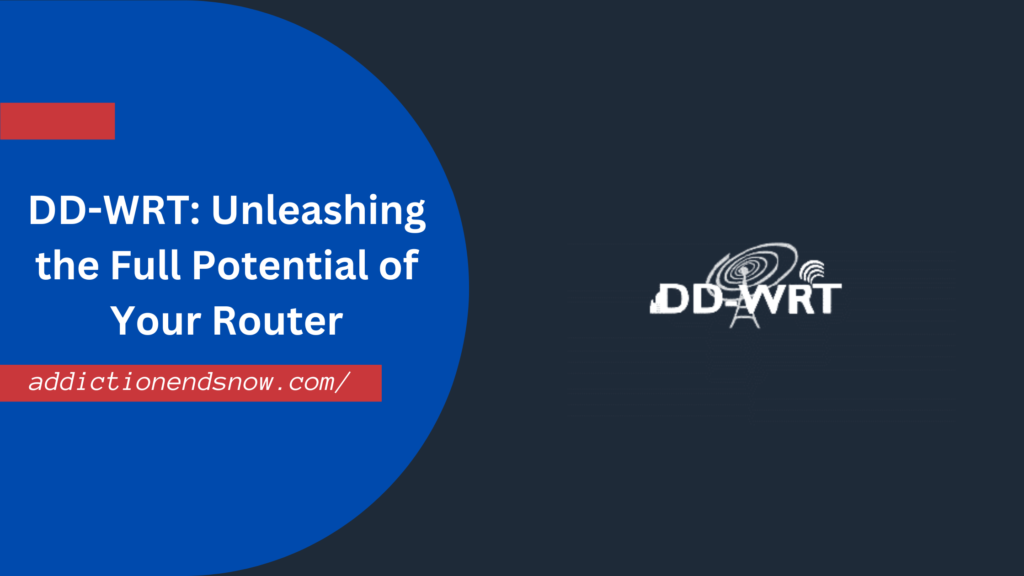If you’ve ever felt limited by the basic settings and capabilities of your router’s stock firmware, DD-WRT might be the solution you’ve been looking for. DD-WRT is a powerful, open-source custom firmware designed to replace the factory firmware on your router, offering advanced features and enhanced control over your network. From boosting your Wi-Fi performance to enabling VPN integration and improving network security, DD-WRT helps transform an ordinary router into a versatile, high-performance networking tool.
But what exactly is DD-WRT, and why should you consider installing it on your router? In this article, we’ll explore what makes DD-WRT so popular among tech enthusiasts, and how it can help you optimize your home network. Whether you’re looking to extend the lifespan of your existing router, improve wireless coverage, or gain access to advanced network management tools, DD-WRT offers a robust solution that can cater to both novice and advanced users.
Key Features of DD-WRT
DD-WRT is packed with features that give users much more control over their network settings than the stock firmware that comes pre-installed on most routers. Whether you’re optimizing your home Wi-Fi, boosting security, or creating a more reliable connection, DD-WRT has the tools to make it happen. Here are some of its standout features:
1. Enhanced Control Over Network Settings
One of the main reasons people switch to DD-WRT is the increased control over their router’s settings. DD-WRT offers a wide array of customization options that allow you to fine-tune your network’s performance.
- Advanced Wireless Settings: With DD-WRT, you can adjust advanced wireless settings, such as signal strength, channels, and bandwidth allocation, to improve overall Wi-Fi performance. You can even extend the range of your Wi-Fi signal to cover dead zones in your home.
- Traffic Management and Quality of Service (QoS): DD-WRT’s QoS feature allows you to prioritize traffic for specific applications or devices. For example, you can ensure smooth streaming on Netflix or lag-free online gaming by giving those activities higher bandwidth priority.
2. VPN Integration for Privacy
Privacy is a growing concern for many internet users, and DD-WRT makes it easy to integrate a Virtual Private Network (VPN) directly into your router. By routing all your devices’ internet traffic through a VPN, you can hide your IP address, encrypt your connection, and maintain privacy across your entire network.
- OpenVPN and PPTP Support: DD-WRT supports popular VPN protocols like OpenVPN and PPTP, allowing you to secure your network from external threats or access geo-restricted content with ease.
3. Improved Security
Security is one of the primary advantages of using DD-WRT. The firmware provides advanced options for managing access and securing your network from potential threats.
- Firewall Configurations: DD-WRT allows for custom firewall rules that can block or restrict specific types of traffic. This helps prevent unauthorized access and strengthens the overall security of your network.
- Access Control: You can set up parental controls, block specific websites, or create a guest network with isolated access, ensuring that only trusted users can connect to your primary network.
- Regular Updates: The DD-WRT community continuously releases updates and security patches, ensuring your router is protected against the latest vulnerabilities.
4. Router Repeater and Bridging
If you’re struggling with poor Wi-Fi coverage, DD-WRT’s repeater and bridging modes can extend your network without the need for additional hardware.
- Repeater Mode: This mode allows your router to act as a repeater, boosting the Wi-Fi signal across larger areas of your home or office.
- Wireless Bridging: DD-WRT enables you to connect multiple routers wirelessly, creating a seamless network that improves connectivity and eliminates dead zones.
Installation Process
Installing DD-WRT on your router can unlock powerful features and give you greater control over your network, but it’s important to follow the process carefully to avoid issues. While DD-WRT installation may seem technical, it’s fairly straightforward if you follow the steps correctly. Below is a step-by-step guide to installing DD-WRT on your router.
1. Checking Router Compatibility
Before you begin, it’s crucial to ensure your router is compatible with DD-WRT. Not all routers support DD-WRT, so you’ll want to confirm that your device is listed on the official DD-WRT router database.
- Step 1: Visit the DD-WRT router database.
- Step 2: Enter your router’s model number and check if it’s supported.
- Step 3: Download the appropriate DD-WRT firmware file for your router.
2. Preparing for Installation
Once you’ve confirmed compatibility, it’s time to prepare for installation:
- Back Up Your Router Settings: Before installing DD-WRT, back up your current router settings. This ensures you can restore them if anything goes wrong during the installation process.
- Use an Ethernet Connection: To minimize the risk of disconnection, connect your computer to the router using an Ethernet cable instead of relying on Wi-Fi.
3. Installing DD-WRT Firmware
Now that you’ve confirmed compatibility and prepared for installation, you can proceed with flashing the DD-WRT firmware onto your router:
- Step 1: Access your router’s admin panel by typing its IP address (commonly 192.168.1.1 or 192.168.0.1) into your browser’s address bar.
- Step 2: Log in using your router’s admin credentials (check your router’s manual for default credentials if you haven’t changed them).
- Step 3: Navigate to the firmware upgrade section, usually found under System or Administration settings.
- Step 4: Upload the DD-WRT firmware file you downloaded earlier and start the upgrade process. Be patient and avoid interrupting the installation.
- Step 5: After the firmware has been successfully installed, your router will reboot. You can now log in to the DD-WRT admin panel using 192.168.1.1.
4. Common Installation Mistakes and How to Avoid Them
Even though the process is generally straightforward, there are some common mistakes that can cause issues during installation:
- Bricking Your Router: If the wrong firmware is installed or the process is interrupted, your router may become “bricked,” meaning it won’t function. To avoid this, always double-check that you’re using the correct firmware version for your router model and ensure that the connection remains stable during the upgrade.
- Power Outages: If a power outage occurs during installation, it can cause firmware corruption. To minimize this risk, consider performing the installation during a time when power interruptions are unlikely.
By carefully following the installation steps and avoiding common mistakes, you’ll be able to successfully install DD-WRT and take full advantage of its advanced features.
Advantages of Using DD-WRT
Installing DD-WRT on your router provides numerous benefits, making it a popular choice for users looking to optimize their network performance, enhance security, and customize their router settings. Below are some of the key advantages of using DD-WRT:
1. Improved Network Performance
One of the primary reasons users switch to DD-WRT is to improve their router’s performance. With DD-WRT, you can optimize your router’s capabilities in ways that aren’t possible with stock firmware.
- Wi-Fi Optimization: By fine-tuning wireless settings such as channel width, transmission power, and bandwidth allocation, you can significantly enhance the speed and range of your Wi-Fi network. DD-WRT allows you to reduce interference and improve signal strength, ensuring a more stable and faster connection across your home or office.
- Traffic Management: DD-WRT’s Quality of Service (QoS) feature enables you to prioritize bandwidth for specific devices or applications. This ensures that high-priority activities like streaming, gaming, or video conferencing receive the bandwidth they need, while lower-priority tasks don’t slow down your network.
2. Cost Savings
DD-WRT can help you save money by extending the life of your current router. Instead of buying new, expensive hardware, you can breathe new life into an older router by installing DD-WRT.
- Revitalizing Older Routers: Many users install DD-WRT on older routers to upgrade their performance without purchasing a new device. This makes DD-WRT a cost-effective solution for those who want to take advantage of advanced features without breaking the bank.
- Avoiding Expensive Upgrades: With DD-WRT, you can gain features like VPN integration, enhanced security, and Wi-Fi optimization—capabilities that are often only available on high-end routers.
3. Advanced Customization
DD-WRT provides a level of customization that is unmatched by stock firmware. This customization allows users to tailor their network settings to their specific needs and preferences.
- VPN Configuration: DD-WRT supports various VPN protocols, allowing you to encrypt all the traffic on your network. This is particularly useful for securing data and accessing geo-restricted content. With DD-WRT, you can easily set up and manage VPN connections directly from your router’s interface.
- Custom Firewall Rules: With DD-WRT, you can implement advanced firewall settings, adding another layer of security to your network. Whether you need to block specific IP ranges or restrict certain types of traffic, DD-WRT allows you to create custom firewall rules that fit your needs.
4. Enhanced Security
Security is a top priority for most internet users, and DD-WRT offers a variety of tools to protect your network from potential threats.
- Regular Security Updates: The DD-WRT community regularly releases updates and security patches, ensuring your router stays protected from vulnerabilities. These updates help keep your network safe and reduce the risk of unauthorized access.
- Advanced Access Controls: With DD-WRT, you can set up advanced access controls to limit who can connect to your network. Whether you want to create a secure guest network or restrict internet access to certain times of day, DD-WRT provides the flexibility to manage access as needed.
Common Issues and Troubleshooting
While DD-WRT offers numerous benefits, it’s important to be aware of potential issues that may arise after installation. Fortunately, most problems have straightforward solutions, and with a bit of troubleshooting, you can keep your network running smoothly. Below are some of the most common issues users face when using DD-WRT and how to address them.
1. Bricking Your Router
One of the biggest risks when installing DD-WRT is “bricking” your router, which happens when the firmware installation fails, rendering the router inoperable. However, bricking can often be avoided and even fixed in some cases.
- How to Avoid Bricking: The most common cause of bricking is installing the wrong firmware for your router model. Double-check that you are using the correct DD-WRT version for your specific router model before flashing. Also, avoid disconnecting the router or interrupting power during installation.
- How to Recover a Bricked Router: If your router appears bricked, try accessing failsafe mode or recovery mode, depending on your router model. Many routers have a reset or recovery function that allows you to re-flash the correct firmware and bring the device back to life.
2. Wi-Fi Connectivity Issues
After installing DD-WRT, some users experience Wi-Fi connectivity issues such as dropped connections or poor signal strength. This can usually be resolved by adjusting your router’s settings.
- Check Wi-Fi Channels: Wi-Fi performance can be impacted by interference from other networks. Use DD-WRT to scan for available channels and switch to the least congested one.
- Boost Signal Strength: In DD-WRT, you can increase the transmission power of your router to improve Wi-Fi signal range. However, be cautious not to increase it too much, as this can overheat the router and cause instability.
3. Slow Internet Speeds
If you notice slower-than-expected internet speeds after installing DD-WRT, it may be due to misconfigured settings.
- QoS Configuration: If you’re using Quality of Service (QoS) to prioritize certain traffic, ensure that the settings are properly configured. Misconfiguring QoS can result in bandwidth limitations for important applications or devices.
- Check VPN Settings: If you’re running a VPN through DD-WRT, it may slow down your internet speeds due to encryption overhead. To mitigate this, choose a VPN server closer to your location or use a faster VPN protocol like WireGuard.
4. Restoring Factory Settings
In some cases, you may want to reset your router to its factory settings, especially if you’ve made changes that are causing issues.
- How to Restore Factory Settings: To reset your router, log into the DD-WRT admin panel and navigate to Administration > Factory Defaults. This will restore all settings to their default state and give you a clean slate to reconfigure your router.
DD-WRT vs Other Custom Firmware
When it comes to enhancing your router’s capabilities, DD-WRT isn’t the only custom firmware available. Two of its main competitors, OpenWRT and Tomato, also offer advanced features for optimizing network performance. In this section, we’ll compare DD-WRT to these other popular firmware options, helping you decide which one best suits your needs.
1. DD-WRT
DD-WRT is one of the most popular custom firmware options because of its user-friendly interface, robust feature set, and compatibility with a wide range of routers. Its balance between usability and customization makes it ideal for both beginner and advanced users.
- Best for: Users seeking enhanced control without diving too deep into technical complexity. DD-WRT offers features like VPN integration, QoS, and repeater modes, all with a manageable learning curve.
- Strengths:
- Broad compatibility with many router brands
- Easy setup for common features like VPNs and Wi-Fi optimization
- Active community support and frequent updates
- Weaknesses:
- Some advanced features may not be as customizable as OpenWRT
2. OpenWRT
OpenWRT is a fully open-source firmware that provides the most flexibility and customization. It’s often preferred by advanced users who want complete control over their router’s configuration. OpenWRT’s modular design allows users to install specific packages tailored to their network’s needs.
- Best for: Advanced users who need maximum customization and are comfortable working with a more technical interface.
- Strengths:
- Extreme customization with the ability to install and remove packages
- Strong community support with frequent updates
- Ideal for complex networking tasks like dynamic routing
- Weaknesses:
- Steep learning curve compared to DD-WRT
- Not as beginner-friendly
3. Tomato
Tomato is another custom firmware that prioritizes simplicity and performance. It’s often used by users who want a lightweight firmware that improves Wi-Fi performance and bandwidth monitoring without too many advanced features.
- Best for: Users who want a simple, lightweight firmware to boost performance without overwhelming options.
- Strengths:
- Clean, easy-to-navigate interface
- Great for bandwidth monitoring and simple network setups
- Excellent Wi-Fi optimization tools
- Weaknesses:
- Limited customization options compared to DD-WRT and OpenWRT
- Fewer updates and less active community support
Which Firmware Should You Choose?
- Choose DD-WRT if: You want a well-rounded, user-friendly option with advanced features like VPN integration and QoS that work well for both beginners and more technical users.
- Choose OpenWRT if: You are an advanced user who needs full customization and control over every aspect of your network’s configuration.
- Choose Tomato if: You prefer simplicity and are looking for a lightweight solution to improve your router’s performance without extensive customization.
Conclusion
DD-WRT is a powerful custom firmware that offers users enhanced control over their routers, enabling features and customization options far beyond what stock firmware provides. Whether you’re looking to improve your network’s performance, increase security with a VPN, or extend your Wi-Fi coverage, DD-WRT provides the tools necessary to transform your router into a highly efficient, versatile networking device.
By installing DD-WRT, users gain access to advanced settings like Quality of Service (QoS), VPN integration, and firewall configurations, all of which help to optimize and secure their home or office networks. Additionally, DD-WRT supports older routers, extending their life and allowing users to maximize the hardware they already own.
For those who are new to custom firmware, DD-WRT strikes the perfect balance between usability and functionality. It is more user-friendly than alternatives like OpenWRT, yet offers deeper customization options than the simpler Tomato firmware. Whether you’re a beginner looking to improve your router’s performance or an advanced user seeking more control, DD-WRT is an excellent choice.



